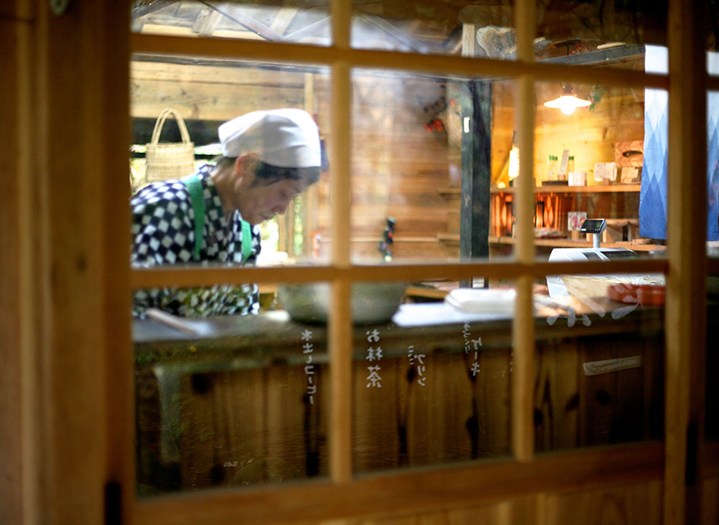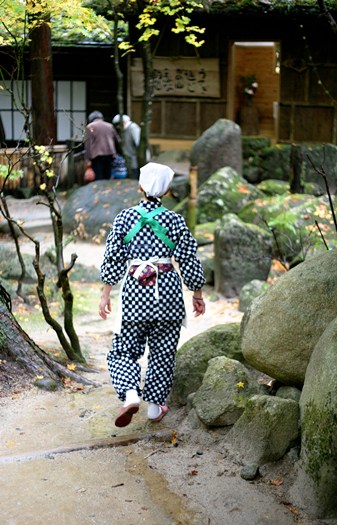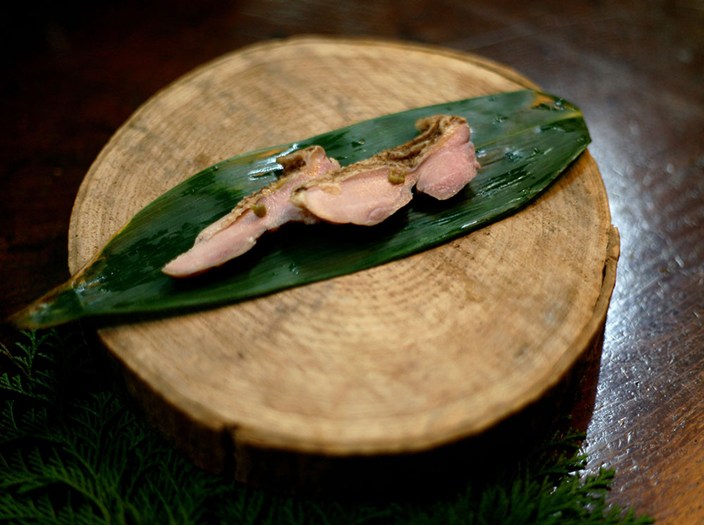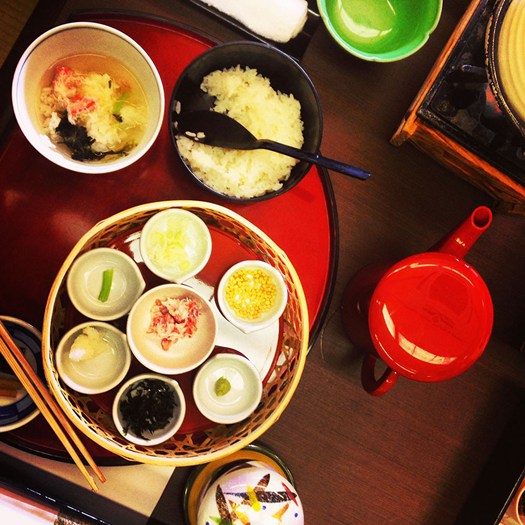TOTTORI, JAPAN - Visiting Tottori feels like you’ve entered a magic forest. The purity of the air, the beauty of the mountains and the trees fantastically-coloured trees of reds, yellows and greens are complemented by small villages and quaint farmhouses with persimmons and daikon radishes hanging out to dry.
We drive along country roads through the lush forest and arrive at Mitaki-En, a thatched-roof restaurant which is not a single structure, but a series of wooden huts, some for dining and some for cooking.
Kettles hang from the ceiling and families kneel around low tables. Our table, decorated with leaves, is soon groaning with beautifully-presented dishes: fried leaves, jellied yam, fresh tofu, charcoal-roasted fish and perfectly-cooked pheasant sliced and served on a round of wood.
The owner, a small, elegant woman with grey hair, explains that everything she serves is grown on her land and prepared daily in her kitchens. Her skin is radiant, her eyes twinkle and I wonder if it is from the forest air or her diet of mountain vegetables.


Above: The women of Tottori live a simple traditional lifestyle like their ancestors.
Over the next couple of days, Tottori continues to enchant. The tall cliffs and sand dunes by the sea are spectacular. I’m especially drawn to the healing hot springs, such as Misasa, which is famous for an ancient temple built on the side of a cliff. The springs here have the highest level of radium in the world. Radon, a gas produced by the decay of radium, is said in low levels to promote natural healing.
At Misasa, there are private and public, indoor and outdoor baths, where people soak in the steamy water under the stars. Traditional inns in the area have their own communal baths, separate for men and women.
Here, I learn the ritual of the onsen, after committing my first cultural faux-pas. I am given a light cotton kimono, which I wrap with the right side over the left. The attendant gasps and explains that’s how they wrap corpses. It should be wrapped left over right.
After that, I decide to follow the lead of the other, experienced, women at the baths. Leaving my kimono in the change room, I head to a row of cleaning stations in the bathing area, where (mimicking the movements of my companions) I sit on a small stool in front of a mirror and scrub myself with a pail of hot water and towel.
After soaking in the bath, I return to the stool and scrub myself clean again, using spa soap on my body and collagen peeling gel for my face. It leaves me with a glow I’ve never experienced before.
Our last evening in Misasa is spent walking the lantern-lit streets, dressed in kimonos, socks, and wooden tong shoes. I feel as if I’m living a dream.
We stop to sample sakes in one shop. Another shop is filled with eclectic second-hand items. The owner brews us coffee using strange glass utensils. Not only is the coffee superb, but it turns out that he’s also an artist and proceeds to draw our portraits.
The next day, we drive a short distance to neighbouring Shimane. At the Yuushi-en Japanese Gardens, we feast on an elaborate lunch of crab and ginseng soup.
The afternoon is taken up with exploring the city of Matsue. High on a cliff is Matsue Castle, a relic of samurai Japan. Nicknamed the “black castle,” this 17th century wooden structure is one of a few remaining medieval castles in Japan.
After hiking up for a closer view, we investigate samurai residences, taste matcha tea and traditional wagashi confectioneries, as well as handmade soba noodles. When our feet are tired, we catch a ride on a riverboat. While travelling the many canals, warmed by a charcoal-heated low table or kotatsu, we discover why Matsue is known as the “City of Water.”
In the evening, we drive into the mountains to Oda, a city on the Sea of Japan coast where there are more traditional inns with hot springs. I rise early the next day to meditate in the warm baths.
Afterwards, I bundle up and explore Oda, home to the Iwami Ginzan Silver Mine, a World Heritage Site, and the quaint Omori Town, with its restored wooden merchant and samurai homes.
After a colourful bento box lunch, we make our way to the Abachi art museum, whose impeccable garden has been voted Japan’s most beautiful for eight years running. Visitors can enjoy the garden’s splendour from the gallery or even better from the tea room while sipping a hot matcha.


Above: Simple farm to table ingredients are used to create some complex Japanese dishes in Tottori.
Shimane and Tottori have left me feeling rejuvenated. Maybe it’s the air, the scenery, the healing springs or the local food and green tea. Or maybe it’s the heartfelt hospitality. Whatever it is, I make sure that when I leave, I have a suitcase full of tea and spa products to go with my wonderful memories in the hope that I can make the glow last a little longer.
Information
Japan’s ANA and Japan Airlines offer flights to Japan from Vancouver and Air Canada offers daily service to Tokyo and Osaka from Toronto, Vancouver and Calgary. / For tourist information on Japan, contact the Japan National Tourist Organization at
www.ilovejapan.ca / Tour East Holidays offers a number of affordable Japan tours. To see their full lineup, go to
www.toureast.com / For more information on Tottori visit:
www.jnto.go.jp/eng/location/regional/tottori/ For more information on Shimane:
www.kankou-shimane.com.en/
About the Author
Gillian was born in raised in Vancouver but has spent the majority of her life living back and forth between Canada and Europe. Her curious nature earned her a degree in Broadcast Journalism at Ryerson University, and brought her to live in Toronto, Paris and Berlin. There has never been a dull day in her career - from from producing documentary series for the Discovery Channel, to working as travel writer, to pursuing her love of food as a private chef and cooking class teacher - this young woman does not believe in limiting your dreams. When she's not busy in her kitchen Gillian can usually be found planning her next adventure!